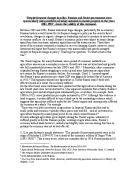How far should the policy of collectivisation of agriculture in the Soviet Union (1929-1940) be regarded as a disaster?
How far should the policy of collectivisation of agriculture in the Soviet Union (1929-1940) be regarded as a disaster?
Collectivisation or collective farming is a system of agricultural organization in which farm labourers are not paid via wages. Instead, the workers receive a share of the farm's net productivity. The Soviet Union undertook the first campaign of collectivisation between 1929 and 1933. There were benefits to collectivisation; it provided a large-scale organisation of food production for the farms. However there were many problems with it; the changes were enforced by the army and by law, also the Kulaks were merely scapegoats for inefficient food production. Stalin amalgamated the farms and put them under state control. In the following paragraphs I will see how far Stalin’s policy of collectivisation of agriculture in the USSR (1929-1940) should be considered as a disaster.
There were advantages and successes during collectivisation. By 1939, 99% of land had been collectivised throughout the USSR and 90% of all peasants lived on one of the 250,000 Kolkhoz. The Soviet Union had modernised with new methods: tractors and fertilisers. What with the modernisation and 17 million peasants leaving the countryside (between 1928 and 1937) to go and work in towns, it is no surprise that by 1937, 97 million tonnes of grain was produced, plus money for exported grain. Collectivisation was partly, a political success. By getting rid of Kulaks, it purged the land of capitalism and Soviet propaganda showed collective farms as a triumph for the state and created a myth of the happy worker.







